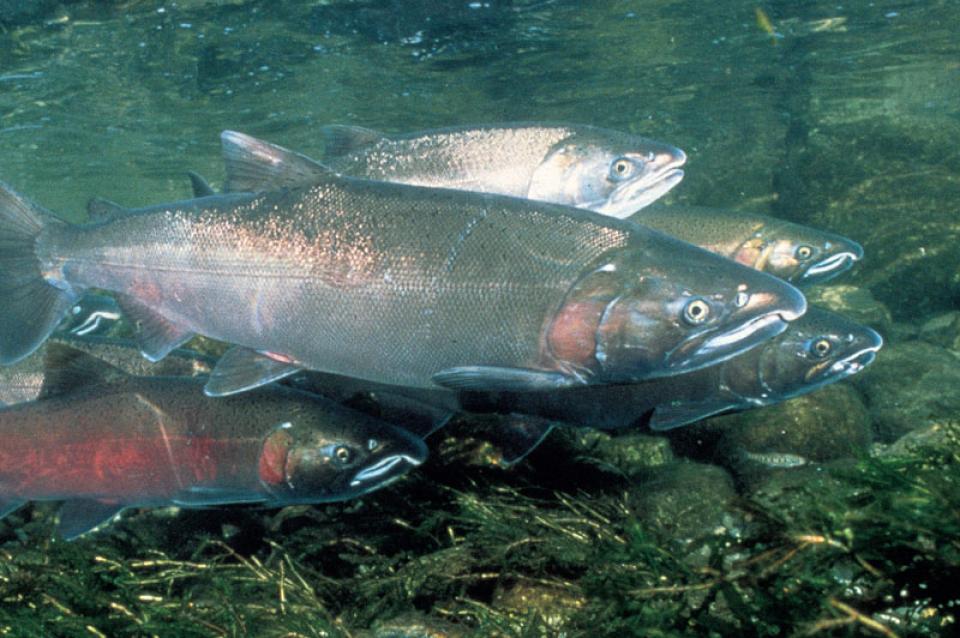Klamath Basin Chinook and Coho Salmon
The Klamath Basin’s Chinook salmon and coho salmon serve a vital role in the watershed.
Together, they are key to the region’s water management, habitat restoration and fishing.
However, years of declining population have led to federally mandated salmon restoration plans—plans that complicate the diversion of Klamath water for agriculture and other uses.
In addition to the environmental consequences, the decline of the Klamath River salmon runs represents a significant economic loss as well. For instance, fishery closures in 2006 prompted Congress to appropriate $60.4 million to assist affected fishermen and tribes in Oregon and California.
Background
Coho salmon, which spawn in the fall, were once abundant in the Klamath Basin, although the historic size of the population is not well established.
The Southern Oregon and Northern California coho populations have declined sharply since the mid-20th century due to the effects of logging, mining, dams, wetland loss, water withdrawals, poor water quality and over-fishing. Compared with Chinook salmon, coho salmon spend significantly more time in freshwater before migrating to the ocean. This trait makes coho populations more susceptible to habitat degradation in rivers and streams.
As a result of the decline of the species, the Klamath River commercial coho fisheries were closed in 1994, and in 1997 the region’s coho were listed as threatened under the federal Endangered Species Act.
Meanwhile, spring-run Chinook populations declined sharply in the 19th century because of hydraulic mining, fishing, water diversions and the construction of dams on the Klamath River’s tributaries. The spring run continued to decline with the construction of the Klamath Hydroelectric Project dams, which blocked access to the Upper Basin, as well as the expansion of logging in the mid-20th century, which covered spawning gravel with silt.
Learn more about the conflicts and agreements over the Klamath’s water use in this video
Today, the fall Chinook run is the largest in the Klamath River, and it is the only salmon run open to fishing.
Some critics of salmon restoration efforts suggest that the hatcheries should simply produce more fish to compensate for the declining wild salmon populations. But heavy production in hatcheries tends to yield an unsustainable population of fish that is dependent on hatchery operations, lacks genetic diversity and crowds out the remaining wild fish.
Chinook and coho salmon also experienced several crises in 2001 and 2002, including depleted water levels and disease. Disease killed tens of thousands of salmon because of low flows in the river, unfavorable channel configuration and crowded conditions.
Next Steps
The needs of each of the Basin’s many water interests — from farmers to tribes to commercial salmon fishermen to wildlife refuges — have often conflicted with one another.
In the last several years, there has been a major multilateral effort to reach a compromise.
This effort has yielded two linked agreements, the Klamath Basin Restoration Agreement and the Klamath Hydroelectric Settlement Agreement. These agreements aim to ease tensions among stakeholders and bring about a major salmon restoration effort and the removal of four hydroelectric dams. This restoration proposal includes a 10-year habitat restoration effort funded by the federal government that has to be approved by Congress.
In the meantime, Klamath tribes were awarded water rights to the Upper Klamath Basin in March 2013. The tribes, including the Kauk and Yurak, now have oversight of Klamath River flows under the “the first in time, first in use” water doctrine. With the Klamath River basin experiencing a severe drought, area farmers are concerned about access to Klamath water for irrigation. These developments have the potential to trigger a new round of Klamath water wars and unravel the Klamath Basin Restoration Agreement.









